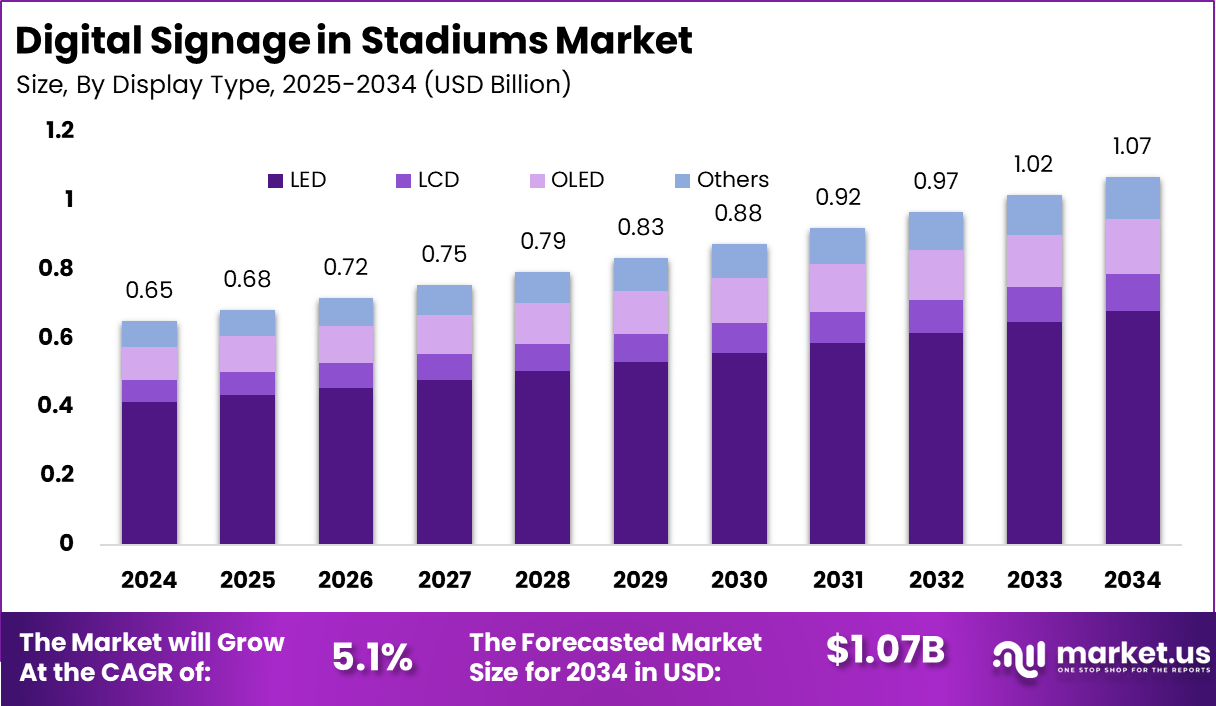Digital Signage in Stadiums Market to hit USD 1.07 Billion By 2034
Updated · Sep 09, 2025

WHAT WE HAVE ON THIS PAGE
Digital Signage in Stadiums Market Size
The Digital Signage in Stadiums Market refers to the use of electronic display systems such as LED, LCD, and OLED screens within sports arenas and stadiums. These digital displays serve multiple purposes including broadcasting live scores, player stats, advertisements, wayfinding directions, and emergency alerts. The aim is to provide an enhanced fan experience, support sponsors with dynamic advertising, and improve overall stadium operations through real-time and engaging content delivery.
Top driving factors behind this market include the increasing demand to improve fan engagement and satisfaction during events, with digital signage shown to boost fan interaction by up to 55%. The growing commercialization of sports and entertainment venues fuels demand as advertising and sponsorship opportunities through digital displays generate new revenue streams. Additionally, government and private investments in upgrading stadium infrastructure for smart and connected venues contribute significantly.

Key Insight Summary
- By screen size, 65-85 inches dominated, holding a 48.3% share.
- By display type, LED led the market, capturing 63.7% share.
- By application, Live Event Displays accounted for the largest portion with 42.1% share.
- Regionally, North America led with 32.6% share, while the U.S. market was valued at USD 0.18 Billion, expanding at a 4.8% CAGR.
Analysts’ Viewpoint
The technologies increasingly adopted include high-resolution LED and OLED display panels that provide superior brightness and clarity suitable for various lighting conditions in stadiums. Cloud-based content management systems allow remote, real-time control of messaging. AI-driven analytics personalize advertising and fan content based on demographics and event type. 5G networks and IoT sensors support instantaneous crowd monitoring for better safety and promotional targeting. Energy-efficient and weatherproof digital signage hardware aligns with stadium sustainability initiatives.
Key reasons for adopting digital signage in stadiums include the ability to significantly enhance the fan experience through interactive and dynamic content such as live stats, instant replays, and social media integration. Digital signage drives commercial revenue by providing attractive platforms for sponsors and advertisers willing to pay premiums for direct audience access during events. It improves navigation and safety by reducing congestion and providing clear instructions in real-time. The scalable and multi-functional nature of these systems helps stadiums quickly shift content between different event types, maximizing venue utilization.
Investment and Business benefits
Investment opportunities arise from ongoing smart stadium initiatives focused on integrating digital signage with mobile apps, augmented reality, e-commerce, and comprehensive fan engagement platforms. There is increasing demand for next-generation signage solutions that offer personalized and interactive experiences. The push for sustainability opens investment in energy-saving technologies and modular displays. Private capital and government infrastructure modernization funds are accelerating market growth, especially in emerging regions upgrading their sports venues.
Business benefits include increased fan engagement leading to higher attendance and more repeat visits, elevated sponsor value through dynamic and targeted advertisements, and enhanced operational efficiencies through better crowd management and communication. Digital signage networks can become significant revenue-generating assets with rental opportunities for advertisers. The technology also elevates stadium appeal and modernizes venue aesthetics, supporting long-term business growth and competitiveness in a crowded entertainment landscape.
The regulatory environment impacting digital signage in stadiums often includes local legislation requirements for safety and security signage. Compliance with data privacy laws is crucial due to the digital collection and processing of fan data for personalized content. Cybersecurity measures must be robust to protect against potential digital threats that could disrupt stadium operations or compromise sensitive information. These regulatory considerations demand ongoing investment in maintaining secure and compliant signage systems.
Driver Analysis
Growing Adoption in Multi-Use Stadium Venues
The digital signage market in stadiums is driven strongly by the growing adoption across diverse venues such as sports arenas, concert halls, and multipurpose stadiums. Stadium operators are increasingly investing in advanced LED and OLED display technologies to replace static boards with dynamic, real-time content. This includes live scores, player stats, instant replays, and advertising, which significantly improve the fan experience by delivering up-to-date and engaging information.
Additionally, the integration of smart technologies like IoT and AI enables personalized content delivery, boosting audience engagement and operational efficiency. This trend is supported by infrastructure investments both from governments and private sectors, especially in emerging markets upgrading their sports venues to modern standards.
This rise of digital signage adoption also aligns with the transformation of stadiums into multi-functional venues that can quickly switch content to accommodate various types of events. Such flexibility enhances profitability and the versatility of these venues, making digital signage not just a feature for sports but an essential tool for concerts, shows, and other large gatherings. These factors collectively make increasing adoption one of the principal drivers of market growth in stadium digital signage.
Restraint Analysis
High Initial Costs and Infrastructure Investment
One of the key restraints slowing the widespread adoption of digital signage in stadiums is the high upfront cost. The installation of advanced digital signage components, such as large high-resolution LED displays, alongside software platforms and integration tools, requires substantial capital expenditure. Smaller stadiums or those in developing regions often find these costs prohibitive, limiting their ability to implement digital signage at scale. Beyond the initial purchase, ongoing costs include maintenance, software updates, and content creation, which add to the financial burden.
This financial challenge is compounded by the technical complexities involved in integrating digital signage into existing stadium infrastructure. Ensuring reliable operation in large, crowded, and sometimes outdoor environments demands specialized expertise and continuous operational support. These barriers slow down market expansion despite strong demand, particularly in areas where budget constraints and limited technical resources exist.
Opportunity Analysis
Integration with Smart Stadium and Fan Engagement Technologies
A significant market opportunity for digital signage in stadiums lies in its integration with emerging smart stadium technologies and advanced fan engagement platforms. Stadiums are adopting IoT sensors, AI-based analytics, and mobile apps that work alongside digital signage to offer personalized, interactive experiences. This includes live polls, social media walls, augmented reality overlays, and targeted advertising, which enhance fan engagement and satisfaction.
The convergence of these technologies not only elevates the spectator experience but also opens new revenue streams through interactive advertising and sponsorship activations. As stadiums increasingly position themselves as year-round entertainment hubs beyond sports, the demand for versatile digital signage solutions that support multiple uses and events will continue to grow. This creates promising growth prospects for the market and encourages innovation in signage technologies.
Challenge Analysis
Data Privacy and Cybersecurity Risks
A major challenge facing stadium digital signage is the increasing concern around data privacy and cybersecurity. Digital signage platforms often collect and analyze large volumes of fan data to tailor content, making them targets for data breaches and hacking attempts. This raises significant privacy issues, requiring stadium operators to comply with strict data protection laws that vary by region. Ensuring that digital signage networks remain secure demands ongoing investment in security protocols and expertise.
Furthermore, cybersecurity risks can potentially disrupt stadium operations if signage systems are compromised, affecting live content delivery and safety alerts. As stadiums become more connected technologically, the complexity of maintaining secure and resilient systems grows, posing both technical and financial challenges. Addressing these risks while balancing the benefits of personalization and connectivity is critical for long-term market growth.
Key Market Segments
By Screen Size
- 22 inches – 32 inches
- 32 inches – 45 inches
- 45 inches – 55 inches
- 55 inches – 65 inches
- 65 inches – 85 inches
- Others
By Display Type
- LED
- LCD
- OLED
- Others
By Application
- Live Event Displays
- Scoreboards
- Advertising
- Wayfinding
- Others
Top Key Players in the Market
- Daktronics
- Samsung Electronics
- LG Electronics
- Leyard
- Sony Corporation
- Panasonic Corporation
- Barco
- Christie Digital Systems
- Planar Systems
- NEC Corporation
- QMS Media
- E Ink Corporation
- Others
Source – https://market.us/report/digital-signage-in-stadiums-market/
Sources

Barry loves technology and enjoys researching different tech topics in detail. He collects important statistics and facts to help others. Barry is especially interested in understanding software and writing content that shows its benefits. In his free time, he likes to try out new healthy recipes, practice yoga, meditate, or take nature walks with his child.









